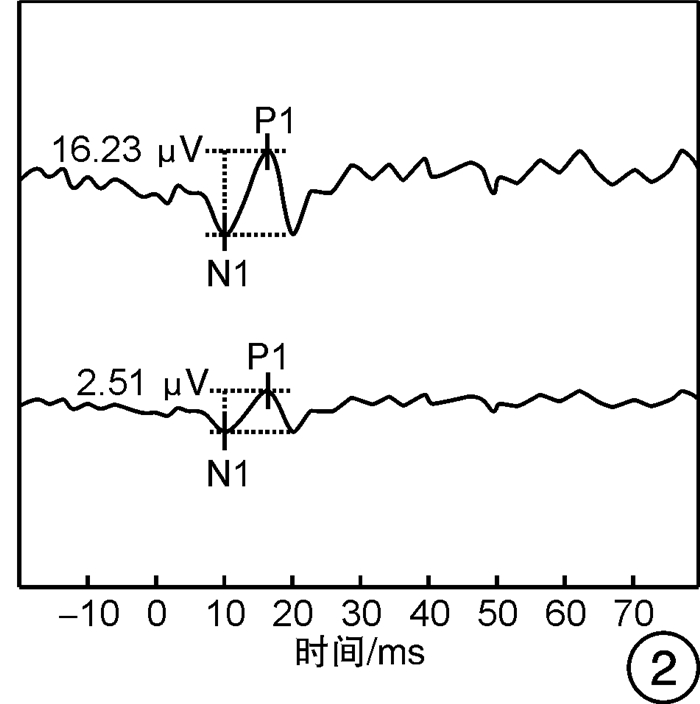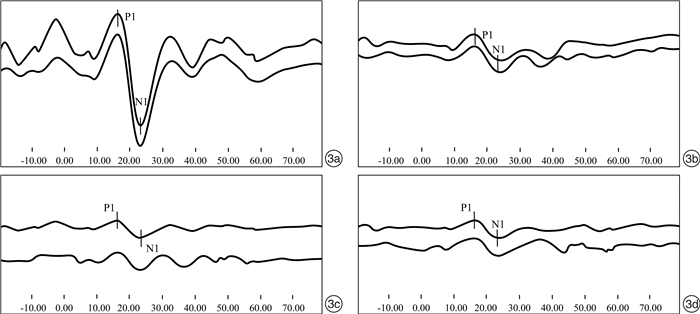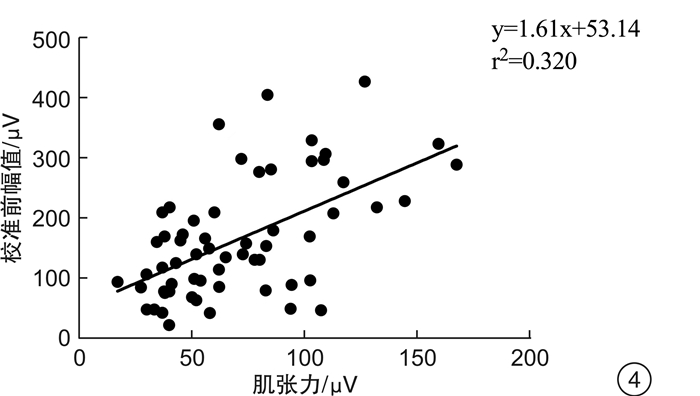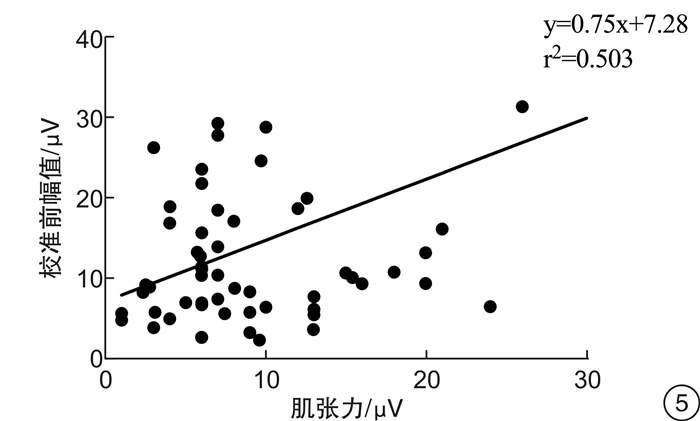Myotonia-rectified bone-conducted vibration vestibular evoked myogenic potential in normal adults
-
摘要: 目的 观察并分析正常成人骨导前庭诱发肌源性电位(BCV-VEMP)相关参数特征,比较肌张力修正前后双侧幅值、幅值不对称比的变化,为耳石器及其传导通路的功能评估以及眩晕疾病的诊断提供更加精准的参考依据。方法 选取30名(60耳)20~32岁正常成年人,以坐姿进行骨导颈肌VEMP(BCV-cVEMP)和眼肌VEMP(BCV-oVEMP)测试。使用B-81骨导耳机给声,刺激强度为129.5 FL,记录修正前后的BCV-cVEMP和BCV-oVEMP的P1、N1潜伏期、P1-N1波间期、P1-N1幅值、幅值不对称比等。结果 BCV-cVEMP和BCV-oVEMP在正常成人中的引出率均为100%。BCV-cVEMP的P1、N1潜伏期分别为(16.00±2.02) ms、(25.04±2.57) ms,波间期为(9.04±1.78) ms。BCV-oVEMP的N1、P1潜伏期分别为(10.39±0.81) ms、(15.85±1.00) ms,波间期为(5.46±0.86) ms。BCV-cVEMP和BCV-oVEMP修正前后的幅值差异均有统计学意义(P < 0.05)。修正后BCV-cVEMP幅值不对称比为(17.03±9.14)%,修正后BCV-oVEMP幅值不对称比为(20.43±11.65)%。结论 BCV-VEMP是一种可行且有效的耳石器功能检测手段。建立修正后的幅值、幅值不对称比等参数的正常范围可为前庭耳石器及其传导通路功能评估及诊断提供更准确的参考依据。
-
关键词:
- 振幅标准化 /
- 骨导前庭诱发肌源性电位 /
- 肌张力修正
Abstract: Objective To study the characteristics of bone-conducted vibration vestibular evoked myogenic potential(BCV-VEMP) in normal adult with and without myotonia rectification, and to provide accurate reference for clinical vestibular function evaluation.Methods Thirty normal adults(60 ears) aged 20-32 years old were selected to receive BCV-VEMP in a sitting position. BCV-VEMP were induced by B-81 bone-conducted vibrator at 129.5 FL, the P1 latency, N1 latency, P1-N1interval, amplitude, and amplitude asymmetry ratios were recorded in two test conditions.Results Clear and repeatable waveforms of BCV-cVEMP and BCV-oVEMP were obtained in all normal adults. The P1 and N1 latencies of BCV-cVEMP were(16.00±2.02) ms and(25.04±2.57) ms, respectively, P1-N1 interval was(9.04±1.78) ms. The N1 and P1 latencies of BCV-oVEMP were(10.39±0.81) ms and(15.85±1.00) ms, respectively, iand interval was(5.46±0.86) ms. The amplitudes of BCV-cVEMP and BCV-oVEMP in two test conditions were statistically significant(P < 0.05). The amplitude asymmetry ratios of BCV-cVEMP and BCV-oVEMP after rectification were (17.03±9.14)% and (20.43±11.65)%, respectively.Conclusion BCV-VEMP is a feasible and reliable tool for vestibular function assessment. The establishment of a normal values such as amplitude and amplitude asymmetry ratio after rectification can provide a more reliable and accurate reference. -

-
[1] Dorbeau C, Bourget K, Renard L, et al. Vestibular evoked myogenic potentials[J]. Eur Ann Otorhinolaryngol Head Neck Dis, 2021, 138(6): 483-488. doi: 10.1016/j.anorl.2021.01.001
[2] 刘嘉伟, 樊小勤, 林颖, 等. 正常青年人骨导眼肌前庭肌源诱发电位特征初步研究[J]. 中国听力语言康复科学杂志, 2017, 8(5): 256-258. https://www.cnki.com.cn/Article/CJFDTOTAL-TLKF201705011.htm
[3] 成颖, 张玉忠, 陈耔辰, 等. 骨导振动刺激下前庭诱发肌源性电位在传导性耳聋患者中的应用[J]. 中华耳科学杂志, 2019, 17(5): 705-709. doi: 10.3969/j.issn.1672-2922.2019.05.017
[4] Sheykholeslami K, Murofushi T, Kermany MH, et al. Bone-conducted evoked myogenic potentials from the sternocleidomastoid muscle[J]. Acta otolaryngol, 2000, 120(6): 731-734. doi: 10.1080/000164800750000252
[5] Vignesh SS, Singh NK, Rajalakshmi K. Tone Burst Masseter Vestibular Evoked Myogenic Potentials: Normative Values and Test-Retest Reliability[J]. J Am Acad Audiol, 2021, 32(5): 308-314. doi: 10.1055/s-0041-1728718
[6] Akin FW, Murnane OD, Panus PC, et al. The influence of voluntary tonic EMG level on the vestibular-evoked myogenic potential[J]. J Rehabil Res, 2004, 41(3B): 473-480. doi: 10.1682/JRRD.2003.04.0060
[7] 韩朝, 田亮, 王璟. 颈性前庭诱发肌源性电位正常值及影响因素的探讨[J]. 中国眼耳鼻喉科杂志, 2015, 15(2): 101-104. https://www.cnki.com.cn/Article/CJFDTOTAL-YRBH201502008.htm
[8] 张琦, 冷辉, 石磊, 等. 改良检查体位对正常青年人颈性前庭诱发肌源性电位的影响[J]. 临床耳鼻咽喉头颈外科杂志, 2019, 33(2): 101-105. https://www.cnki.com.cn/Article/CJFDTOTAL-LCEH201902002.htm
[9] 沈佳丽, 孙夏雨, 陈向平, 等. 听力正常儿童骨导前庭诱发肌源性电位正常值的建立[J]. 山东大学耳鼻喉眼学报, 2020, 34(5): 72-77. https://www.cnki.com.cn/Article/CJFDTOTAL-SDYU202005013.htm
[10] 陈建勇, 孙夏雨, 沈佳丽, 等. 原发性良性阵发性位置性眩晕患者VEMP异常率的临床观察[J]. 山东大学耳鼻喉眼学报, 2020, 34(5): 51-55. https://www.cnki.com.cn/Article/CJFDTOTAL-SDYU202005009.htm
[11] 林颖, 钟波, 樊小勤, 等. 骨导刺激与气导刺激的眼肌前庭诱发肌源性电位对比研究[J]. 中华耳鼻咽喉头颈外科杂志, 2020, 55(4): 338-343.
[12] Dyball AC, Govender S, Taylor RL, et al. Bone-conducted vestibular and stretch reflexes in human neck muscles[J]. Exp Brain Res, 2020, 238(5): 1237-1248. doi: 10.1007/s00221-020-05798-8
[13] Rosengren SM, Colebatch JG, Young AS. Vestibular evoked myogenic potentials in practice: Methods, pitfalls and clinical applications[J]. Clin Neurophysiology Pract, 2019, 4: 47-68. doi: 10.1016/j.cnp.2019.01.005
[14] Fife TD, Colebatch JG, Kerber KA, et al. Practice guideline: Cervical and ocular vestibular evoked myogenic potential testing: Report of the Guideline Development, Dissemination, and Implementation Subcommittee of the American Academy of Neurology[J]. Neurology, 2017, 89(22): 2288-2296. doi: 10.1212/WNL.0000000000004690
[15] Lee KJ, Kim MS, Son EJ, et al. The usefulness of rectified VEMP[J]. Clin Exp Otorhinolaryngol, 2008, 1(3): 143-147. doi: 10.3342/ceo.2008.1.3.143
[16] Shahnaz N, David EA. Normal values for cervical and ocular vestibular-evoked myogenic potentials using EMG scaling: effect of body position and electrode montage[J]. Acta Otolaryngol, 2021, 141(5): 440-448. doi: 10.1080/00016489.2021.1887517
[17] 于澜, 赵苗苗, 李清溪, 等. EMG修正对颈部及眼部前庭诱发肌源性电位的影响[J]. 中华耳科学杂志, 2017, 15(2): 147-152. https://www.cnki.com.cn/Article/CJFDTOTAL-ZHER201702003.htm
[18] McCaslin DL, Jacobson GP, Hatton K, et al. The effects of amplitude normalization and EMG targets on cVEMP interaural amplitude asymmetry[J]. Ear Hear, 2013, 34(4): 482-490. doi: 10.1097/AUD.0b013e31827ad792
[19] Isaradisaikul S, Strong DA, Moushey JM, et al. Reliability of vestibular evoked myogenic potentials in healthy subjects[J]. Otol Neurotol, 2008, 29(4): 542-544. doi: 10.1097/MAO.0b013e31816c7c25
[20] 张青, 许信达, 牛晓蓉, 等. 年龄因素对气导声刺激诱发的眼肌和颈肌前庭诱发肌源性电位的影响[J]. 中华耳鼻咽喉头颈外科杂志, 2014, 49(11): 897-901. doi: 10.3760/cma.j.issn.1673-0860.2014.11.005
[21] Welgampola MS, Colebatch JG. Vestibulocollic reflexes: normal values and the effect of age[J]. Clin Neurophysiol, 2001, 112(11): 1971-1979. doi: 10.1016/S1388-2457(01)00645-9
-




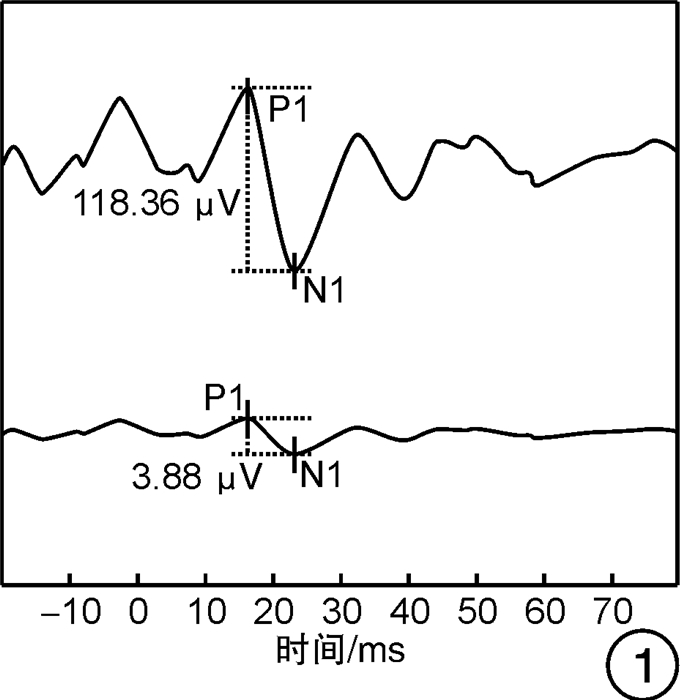
 下载:
下载:
